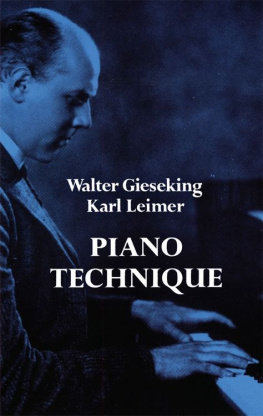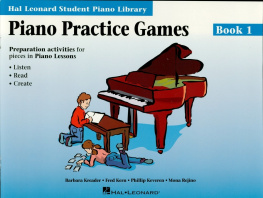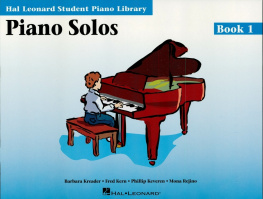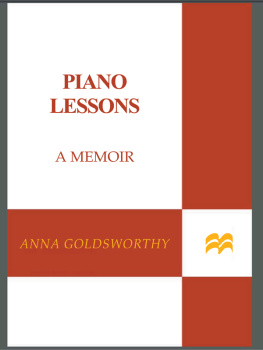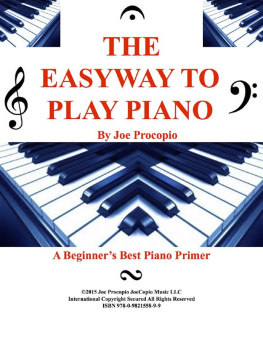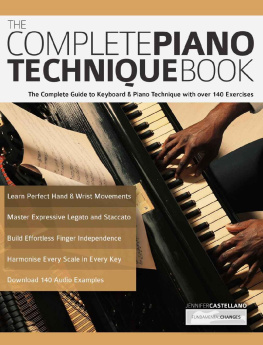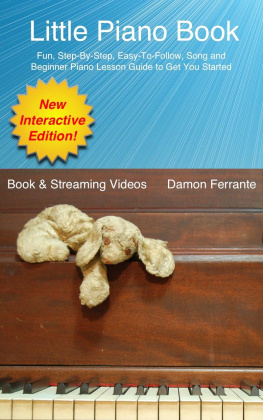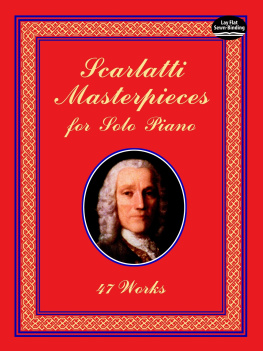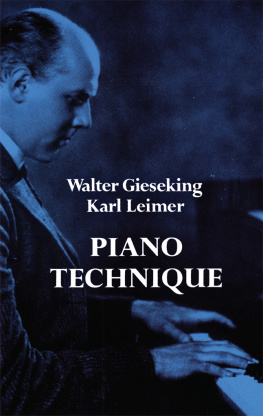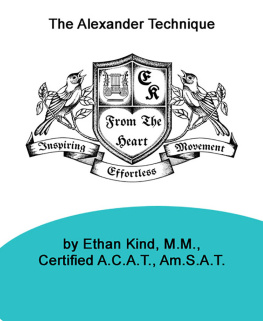
PIANO TECHNIQUE
consisting of the two complete books
THE SHORTEST WAY TO PIANISTIC PERFECTION
and
RHYTHMICS, DYNAMICS, PEDAL AND OTHER PROBLEMS OF PIANO PLAYING
Walter Gieseking
and
Karl Leimer
DOVER PUBLICATIONS, INC.
NEW YORK
This Dover edition, first published in 1972, contains the unabridged text of the following two books:
The Shortest Way to Pianistic Perfection, by Leimer-Gieseking, originally published by the Theodore Presser Co., Bryn Mawr, in 1932.
Rhythmics, Dynamics, Pedal and Other Problems of Piano Playing, by Leimer-Gieseking (translated by Frederick C. Rauser), originally published by the Theodore Presser Co. in 1938.
International Standard Book Number: 0-486-22867-3
Library of Congress Catalog Card Number: 72-82075
Manufactured in the United States by Courier Corporation 22867321
www.doverpublications.com
CONTENTS
THE SHORTEST WAY TO PIANISTIC PERFECTION
CONTENTS

FOREWORD
The present treatise explains the method of my piano playing, that is, what I consider to be the foundation of my pianistic technique. It is to me a pleasant duty to mention that I owe to Mr. Karl Leimer, under whom I studied from 1912 to 1917, my entire schooling as a pianist. And, now that over twelve years have passed, and after this period of testing, I still am an unconditional partisan of this Leimer method, which I consider the best and most rational kind to bring pianistic possibilities to their highest state of perfection.
Karl Leimer educates the pupil at first to self-control; he shows the pupil how to hear himself. This critical self-hearing is, in my opinion, by far the most important factor in all of music study! Playing for hours without concentrating the thoughts and the ear on each note of the certain study in hand is wasted time! Only trained ears are capable of noticing the fine inexactitudes and unevennesses, the eliminating of which is necessary to a perfect technique. Also, through a continuous self-hearing, the sense for tone beauty and for finest tone shadings can be trained to such a degree that the student will be enabled to play the piano with an irreproachable technique and with a feeling for the sound-beautiful. Really accurately rhythmical playing can be achieved only through severe self-control. How unsatisfying, yes, how unbearable, rhythmically inexact music making is to the listener whose sense of time values, combinations and variations has been highly developed, is indescribable. Unfortunately, and especially in Germany, rhythmically irreproachable playing is seldom heard; and often it even verges on the inartistic. Too much attention is never paid that exact note for note execution of all marks of the composer is the first thing the interpreter should master. I still am grateful to Mr. Leimer that he has trained me to pay unconditional respect to the intentions of the composer. Only the most careful following of all his markings makes it possible to live in the thought and emotional world of a master and thereby to realize a perfect rendition of his works.
In my musical activities I have realized that it is mostly the less gifted musicians, technically and emotionally, who do not fully grasp the content or message of a work and who, because of these limitations, take liberties and retouch a piece in order to make it interesting, which in fact is always a falsification. The young musician almost never understands how difficult it is to play really correctly. That means not only finger-technically but also expression-technically, exactly according to the wishes of the composer. This is possible only by a complete mastery of all kinds of touches and shadings. And this possession must go so far that the musician is able to call up the visionary presentation of a tone or a phrase, in such a way that it automatically transfers itself into the necessary hand and arm movements. The Leimer system, in avoiding all not absolutely necessary movements and in not using all not momentarily needed muscles, and these in relaxation, is undoubtedly the system which carries one quickest to this goal.
It is partly on my insistence that Mr. Leimer has decided to publish these foundation principles of his (or, better, our) system; and I hope that very many pianists will receive much benefit from them.
WALTER GIESEKING.
Hanover, 1930
AN EPOCH-MAKING PEDAGOGICAL ACHIEVEMENT
An Introduction
The late Theodore Presser had unlimited admiration for the teacher who showed in his work real creative and constructive ability. For the teacher who did not think for himself, but merely followed the pedagogical grooves of past decades, he had little respect.
The pronounced progress made in American pianistic methods, by Mason, Mathews and others, was due largely to the fact that these pioneers looked upon the art through spectacles unclouded by arbitrary conventions of the past. Leschetizky, Matthay and Philipp, in Europe, displayed a similar attitude of mind, in that the structures they erected were based upon the past but represented new developments along logical, progressive lines.
During the past few decades the writer has been in intimate contact with the foremost pedagogical methods and materials of the piano and has had frequent conferences with their foremost exponents. This experience has made clear that there is no one supreme method; and the authors of this work display no little audacity in the title, The Shortest Way to Pianistic Perfection Still, after reading the work carefully, one must have the impression that it would be difficult to set down a course that would be more direct, more sound and yet more constructive, through its elimination of the unnecessary. Walter Gieseking is recognized by the great pianists of Europe and America as one of the dominating factors in the progress of the art of playing their instrument. Many look upon him as the greatest of the modern school of virtuosi. In this book we have the unusual combination of the methods and practices of the teacher, Karl Leimer, and of his most distinguished pupil, Walter Gieseking. The teacher and the student of pianoforte playing, who make a close study of this very clear and practical work, will unquestionably benefit by a marked improvement in technic and interpretation,
JAMES FRANCIS COOKE
Chapter I
FOUNDATIONS OF MY METHOD
Training of the Musical Ear
Having experienced many fine and exceptional results with my pupils, it has been suggested that I write down my views regarding modern pianoforte playing and thus explain the manner in which I train my students in order to obtain the said success. The following notes lay no claim to completeness; they simply present, in general, the rudiments of my system. A complete insight into my mode of treatment of pianoforte playing could be gained, after all, only through my personal instruction.
My method has brought about a style of execution which differs greatly from the usual piano playing. This method is based upon careful observation and is, I think, perfectly natural; but the way in which I have made use of these principles, and have arranged them into a system, is, according to my experience, the shortest, if not the only way, to develop completely the musical talents of a pupil and to enable him to use the greatest power of expression in his renderings. Doubtless it is only the intelligent and talented pupil who will be able fully to realize and to make complete use of the illimitable possibilities of developing technique and interpretative ability. But my method, with small individual variations, can be generally used; and if rightly understood, it will bring the greatest benefit to every pupil, if he understands how to go to work. Talented pupils obtain results which they would not have thought possible.
Next page
